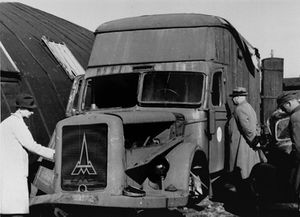Difference between revisions of "Szymon Srebrnik (M / Poland, 1930-2006), Holocaust survivor"
| Line 24: | Line 24: | ||
[[Category:Holocaust Children, 1930 (subject)|1930 Srebrnik]] | [[Category:Holocaust Children, 1930 (subject)|1930 Srebrnik]] | ||
[[Category:Holocaust Children, Poland (subject)|1930 Srebrnik]] | |||
[[Category:Holocaust Children's Earliest Narratives (subject)|1930 Srebrnik]] | [[Category:Holocaust Children's Earliest Narratives (subject)|1930 Srebrnik]] | ||
Revision as of 05:32, 30 September 2020
Szymon Srebrnik (M / Poland, 1930-2006), Holocaust survivor.
- KEYWORDS : <Poland> <Lodz Ghetto> <Chelmno> <mascots> <errand boys> <witnesses>
Biography
NOTES : Born in Lodz in 1930, Szymon lived the hardships of the Lodz Ghetto. His father was killed before his eyes at Lodz. In 1944 Szymon (age 13) and his mother were deported to Chelmno. The mother died in the gas vans (there were no gas chambers in Chelmno). The carbon dioxide emissions from the engine were pumped into the back of the van, and by the time the driver had reached the burial site in a nearby forest, all of the Jews would be dead. If any of them happened to still be alive, they were shot. The bodies were disposed of by either burial or burning.
A small number of strong, healthy men were kept alive for awhile in order to help dispose of the bodies and sort through all the belongings of the dead Jews. They were kept in iron shackles 24 hours a day to prevent escape. They slept in the granary. These people were usually killed within days or weeks and replaced by others from new transports. Our Szymon, however, lasted for about ten months, as he became a sort of mascot of the camp. Although chained as all the other prisoners he was very agile and funny and entertained the German soldiers with his singing. This did not prevent the SS to shoot him in the head at the liquidation of the camp, on January 18, 1945, two days before the Russian troops arrived. He survived. The bullet missed his vital brain centers. A Polish farmer found him, freed him from his chains, and sheltered him until the arrival of the Russian doctors.
After liberation became one of the main witnesses against Nazi atrocities in Poland (only three people are known to have survived at Chelmno). This is the text of the testimony he gave on June 29, 1945:
In September 1945 Szymon emigrated to Israel. He went on to testify at Adolf Eichmann‘s trial in 1961, and in 1978, he went back to visit Chelmno for Claude Lanzmann’s film documentary Shoah.
- Shoah (3m-9m)

